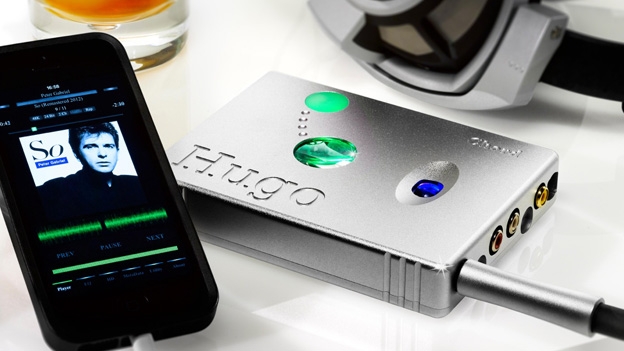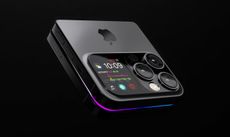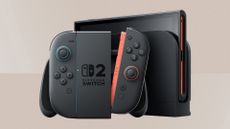Chord Hugo review
The tiny Chord Hugo headphone amp packs a remarkable 32-bit DAC

-
+
Superb build quality
-
+
Cutting-edge audio conversion
-
+
Accepts all audio formats
-
-
Unlabelled switches and inputs
-
-
No balance outputs
-
-
No internal HDD
Why you can trust T3




It's a lot of money, but the 32-bit DAC rinses stunning sound from your mobile music and your hi-fi. Check out our Hugo Chord review
The Chord Hugo is like a high-end hi-fi component, but built to go wherever you go (hence the name Hu-go, geddit?) this headphone amp is here to ensure you always get the most from your digital music.
It's smaller than Chord's continuing Chordette Toucan and more expensive due to the new 32-bit DAC that puts it at the cutting edge of digital to analogue conversion. So if you thought headphone technology maxed out with Dr Dre's Beats Pro, then you're better advised to check out more reasonably priced preamps like the excellent £100 Cambridge Audio DacMagic XS. This uncompromising headphone amp is strictly for the audiophiles.
Chord Hugo: Size and build
British brand, Chord Electronics, does not do bland boxes. It considers casework as important and integral as the components within. In fact, you can peer in through a magnifying porthole at the blinking circuitry, to see with your own eyes, which input is currently playing and at what bit-rate.
It's a delightful detail found on most of Chord's hi-fi components and like the Chordette Toucan, it's engineered (some might say over engineered) from aircraft grade aluminium to make it utterly tank proof. No really, there's wonderful YouTube footage of a Soviet tank failing to make any impact on a Chord headphone amp here.
At just under half a kilo, it is substantial, but you can rest assured that Hugo will survive any trips you make and aesthetically, that hard anodised finish happens to compliment titanium MacBooks and Sennheiser HD 800 reference headphones rather well.
Chord Hugo: Features
Hugo's MO is to amplify the digital signal from any source, be that a phone, iPod, laptop or hi-fi separate, and output it in the analogue domain to your headphones, or through stereo RCA outputs if you're connecting to a static hi-fi.
Inputs include both optical and coaxial digital and two micoUSB ports, one for standard resolution and one for high-resolution audio. Why bother with SD USB? Well, it will work with any 16-bit device including older mobile phones and uses slightly less battery power than the HD USB input.
You can also make an A2DP Apt-X Bluetooth connection with a suitably equipped wireless device.
It's the USB 2.0 input that is the most interesting though, as this accepts 32-bit feeds and seemingly any hi-res file format including 32/384 PCM and DSD 128.
Additional features include a colour-changing digital volume dial that can be bypassed in DAC mode and three crossfeed sound modes.
Chord Hugo: Setup
It's an unconventional design to say the least and that means the setup and operation is a little eccentric too. These days, it's rare to reach for the manual, especially when you're dealing with something as straight forward as a headphone amp, but believe me, you will need to keep these instructions close by until you learn every operation.
For starters, the on/off switch is tucked away next to the second USB port and you'll need fingernails to throw it. Luckily there are only two buttons, one to toggle through the inputs and one to change sound modes. Hold this one down to deactivate the volume wheel, but whatever you do, take your headphones off first if you want to keep your eardrums as all outputs revert to full line-level volume at that point.
We found that the recessed microUSB ports and slightly constricted SPDIF port excluded some cables with chunkier connections. We also had some trouble making an Apt-X Bluetooth connection, until discovering that Bluetooth must first be selected by Hugo and even then, it might not join immediately.
However, instead of an LCD display, we much prefer Chord's idea of actually seeing which circuit LED is lit through the round window even though this does mean learning a Chord's colour coding. A blue light indicates a Bluetooth connection for example, and white for HD USB.
Another LED lets you know how much crossfeed is being applied (if any) and a third indicates remaining battery life.
Even more fun is the illuminating circle that changes colour according to the sample frequency Hugo detects from red at 44kHz to white for a DSD 128 feed.
Windows users should note that driver software is required from Chordelectronics.co.uk, but Apple and Android users are good to go.
Chord Hugo: Sound quality
As you might hope, given the price tag, Hugo does a fine job of amplifying your digital music library. Converting digital files to an analogue signal you can hear is pure number-crunching, but unplug the headphones from your phone for a minute and add Hugo into the chain and you begin to understand how important that task is.
Beginning with regular MP3 files ripped from CD at 192kbps (the highest offered by Apple for MP3) and there's already a detectable difference in the accuracy of the soundstage. Classical pieces seem more focused and the instruments placed more believably in front of you when you eyes are closed.
Ripping larger 16-bit WAV files into iTunes files yields even better results, but it's when you encounter the lossless audio formats such as Direct Stream Digital (DSD) and Digital eXtreme Definition (DXD) that Hugo really begins to make sense.
These rarified files need converting for iOS and Android devices, but our MacBook played them happily, streaming them wirelessly over Apt-X Bluetooth to Hugo and our Sennheiser HD 800 headphones.
Thanks to Hugo, the wide dynamic range is maintained, in fact, your ears can't even detect the sounds at the top and bottom of this sonic spectrum, but apparently, that is why hi-res music sounds so natural to us. It certainly sounds utterly lifelike through Hugo.
Experimenting with the three crossfeed modes effectively opens up the soundstage, moving the component parts of the orchestra further in from of you without introducing any unnatural effects.
Hi-fi purists will no-doubt prefer to disable the crossfeed effect and bypass the volume when connecting to Hugo to a hi-fi for DAC duty. We were rewarded with a fabulously detailed and dynamic sound field when we tried this while using a MacBook loaded with DSD files as the source component.
Hugo seems to have the effect of focusing and decluttering complex classical arrangements in the most desirable way.
Chord Hugo: Verdict
Perhaps Hugo's most satisfying application is simply plugging an iPhone 5 (via a thunderbolt-to-USB adapter) into the HD USB port and enjoying high-resolution audio on the train. So while every other commuter makes do with all manner of audio compression, your ears are being washed in a range of sonic frequencies wider than they can detect.
Hugo fits in a coat pocket and its battery plays for up to 14 hours, so nobody will suspect your auditory ecstasy.
Admittedly, it's difficult to see how a headphone amp can cost the same as a MacBook, but if you want the best, and this is it, then you must pay.
Chord Hugo release date: March 2014
Chord Hugo price: £1,200
Sign up to the T3 newsletter for smarter living straight to your inbox
Get all the latest news, reviews, deals and buying guides on gorgeous tech, home and active products from the T3 experts
-
 New evidence suggests Apple's taking its foldable iPhone seriously
New evidence suggests Apple's taking its foldable iPhone seriouslyAnd it might bring something different to the party too
By Britta O'Boyle Published
-
 Nintendo officially reveals two key Switch 2 features – even if it didn't mean to
Nintendo officially reveals two key Switch 2 features – even if it didn't mean toIts latest app and marketing pages unveil interesting updates on the Nintendo Switch 2
By Rik Henderson Published
-
 This is the world's first multi-purpose garden robot – it even has a leaf sweeper attachment
This is the world's first multi-purpose garden robot – it even has a leaf sweeper attachmentYou won't even have to lift a finger
By Lizzie Wilmot Published